Rashes in Children (with Pictures)
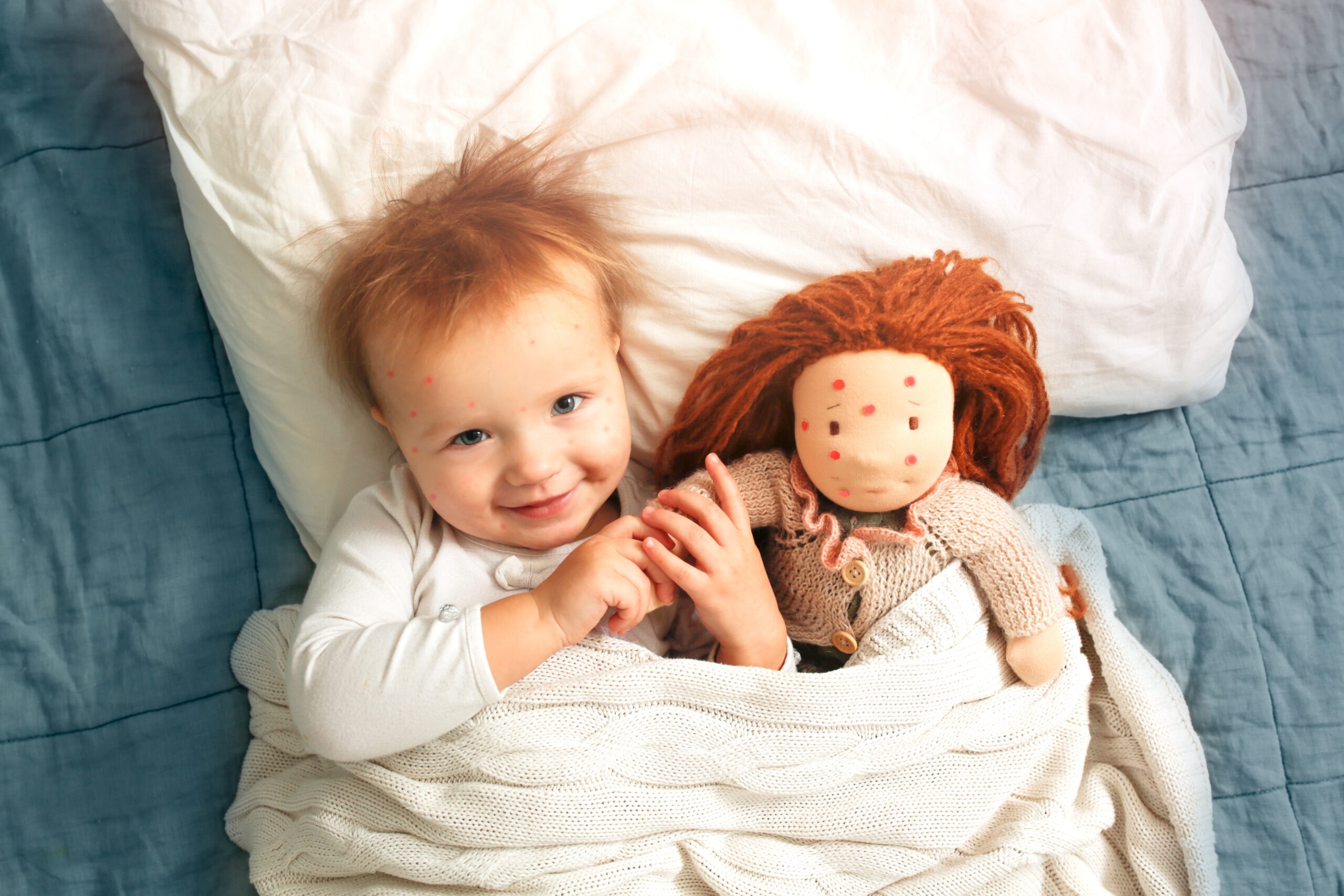
Rashes are very common in the first few years of life. They are often caused by illnesses that can be treated safely and effectively at home with the right help. Here are the top causes of rashes in childhood and what you can do to treat them.
Rashes with high fevers
Chickenpox
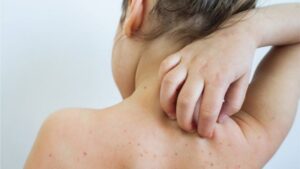
Small, itchy spots with a fever could be chickenpox. They start as small bumps that turn into blisters and then scabs before healing. Chickenpox is a viral infection and can usually be treated at home.
Use light clothing, cooling creams and gels and pain killers when needed. It’s very infectious so your little one will need to stay away from school or nursery until all the spots have formed a scab. This is usually 5 days after the spots appeared.
Impetigo

Sores or blisters that start in one place, burst and leave crusty, golden-brown patches could be impetigo. The sores or blisters can be itchy, get bigger or spread to other parts of the body. Impetigo is caused by a bacterial infection that is treated with antibiotic creams or tablets. You should speak to your doctor if you think your child has a rash like this.
Measles
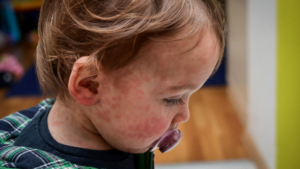
A spotty rash that appears on the head or neck and spreads to the rest of the body along with sore eyes, cough and cold symptoms and a high fever could be measles. Measles is a virus that can cause serious illness and can be easily passed to others. The vaccine for measles is given routinely in most countries, from one year old. Children under one, and those who haven’t been vaccinated are at risk. You should speak to your doctor if you think your child has symptoms of measles.
Fifth Disease
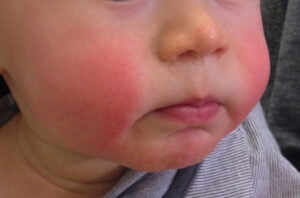
A rash on one or both cheeks with a high temperature, runny nose, sore throat and headache may be Fifth disease. Also called, 'Slapped Cheek' Syndrome, this viral infection can usually be treated at home. Treat the fever by keeping the environment cool, using light clothes and giving paracetamol or ibuprofen. The illness usually lasts a few days before your little one will start to feel better.
Hand, Foot and Mouth Syndrome
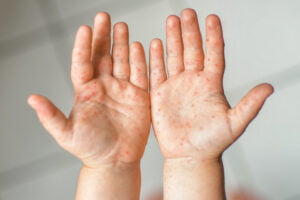
Blisters on the hands and feet, with ulcers in the mouth, are the symptoms of Hand, Foot and Mouth disease (HFM). This is another viral infection can usually be treated at home. Give soft foods and plenty of fluids and with pain killers as the ulcers in the mouth can be very sore. It usually takes around a week before your little one will start to feel better after an infection with HFM.
Scarlet fever
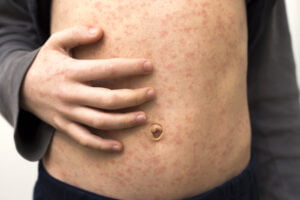
A rash of small, raised bumps that feels rough, like sandpaper, that happens after a few days of sore throat and tongue and fever could be scarlet fever. Scarlet fever is a bacterial infection that requires antibiotics so you should talk to your doctor if you think your child has these symptoms.
Itchy rashes
Eczema

Eczema is a very common cause of an itchy rash. Eczema has a different appearance in the acute stage where it appears red and itchy and later becomes dry and cracked. Eczema can appear anywhere on the body but is common at the joints of the knees, ankles, elbows and neck. You can treat mild eczema at home with moisturising creams and soap replacements, but you should speak to your doctor about long term treatments.
Allergy (Hives)
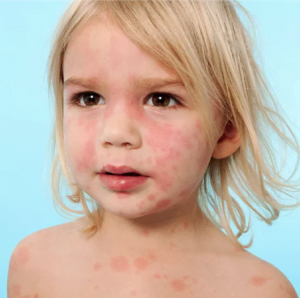
Raised, itchy patches or spots could be caused by an allergic reaction (hives).
Hives can usually be treated at home with antihistamine creams or tablets if needed, it usually goes within a few hours once the cause is found and removed. You should get urgent medical advice if you notice this rash alongside swelling around your child's mouth, if they seem to be struggling to breathe or if they have a known allergy, such as to nuts.
Heat Rash
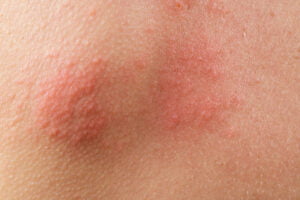
A rash of small, raised spots that feels itchy could be heat rash (prickly heat). It’s especially common in summer months and can be treated at home with remedies like calamine lotion and aloe vera. It usually goes away within a day or two.
Molluscum
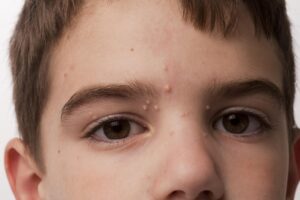
Molluscum contagiosum is a viral infection that causes small, firm, raised spots that can be slightly itchy. The spots vary in colour from skin colour, darker brown, or pink. The spots don’t cause harm and usually don’t need treatment, but it can take weeks or even months to go completely. Your little one can still go to school or nursery but should avoid sharing towels and clothes.
Ringworm
Ringworm is actually nothing to do with a worm, it’s a common fungal infection, the same type that causes athlete’s foot. The infection causes itchy, dry, ring-shaped patch of skin on the body or scalp. It can look quite similar to eczema. Ringworm can usually be treated at home with antifungal creams, you can get advice from the local pharmacist on which treatments to use.
Rashes in newborn babies
Rashes in newborn babies are very common. They are almost always a normal part of the skin adapting to the outside world. Your midwife is a great person for information and advice on newborn rashes.
Milia

Very small spots, called milia, often appear on a baby's face when they're a few days old. Milia may appear white or yellow, depending on your baby's skin colour. They usually go away within a few weeks and don’t need treatment.
Erythema Toxicum Neonatorum (ETN)

Despite having a scary name and dramatic appearance, ETN is a harmless rash that's very common in the first few weeks of life. It causes red patches with yellow and white spots and can be seen all over the body that can look very dramatic. The rash can disappear and reappear in the first few weeks of life and is thought to be happen as your babies immune system becomes familiar with the healthy bacteria that live on our skin. It gets better without treatment and does not scar.
Nappy Rash

If your baby has a red and sore bottom, it’s likely to be nappy rash. This is usually due to inflammation from the acids in wee and poo against the skin. Nappy rash can usually be treated at home by increasing the frequency of nappy changes, washing regularly with warm water and using a nappy cream to create a waterproof barrier while healing occurs. You should speak to your doctor or pharmacist if the rash doesn’t improve within a week or two with these treatments.
Find out more about nappy rash
Baby Acne
Credit: https://www.medicalnewstoday.com/articles/324234#baby-acne
Spots that appear on a baby's cheeks, nose or forehead in the first month are likely to be baby acne. This happens because of the hormonal changes after your baby is born. It doesn’t cause harm and usually gets better within a few weeks without treatment.
Cradle Cap
Yellow or white, greasy, scaly patches on your baby's scalp or face suggest cradle cap. Though it can look sore, cradle cap does not bother your baby and is not infectious. It can be treated at home with baby shampoo, moisturising creams and gentle brushing.
We hope you found this article useful. Did you know that the Poppet community is a great place to find more helpful tips and resources for your family as well as flexible childcare from local parents and approved providers, all at the touch of a button. Register here today!
And here’s a list of other great resources to keep your family healthy and well
https://www.healthychildren.org/
https://www.nidirect.gov.uk/conditions/childhood-illnesses
https://www.sja.org.uk/get-advice/first-aid-advice/paediatric-first-aid/
https://firstaidchampions.redcross.org.uk/primary/first-aid-skills/
https://www.healthhub.sg/programmes/183/parent-hub
Disclaimer: This article is for education purposes and does not constitute medical advice. You should seek advice from a trained medical professional if you have concerns about your child’s health.


